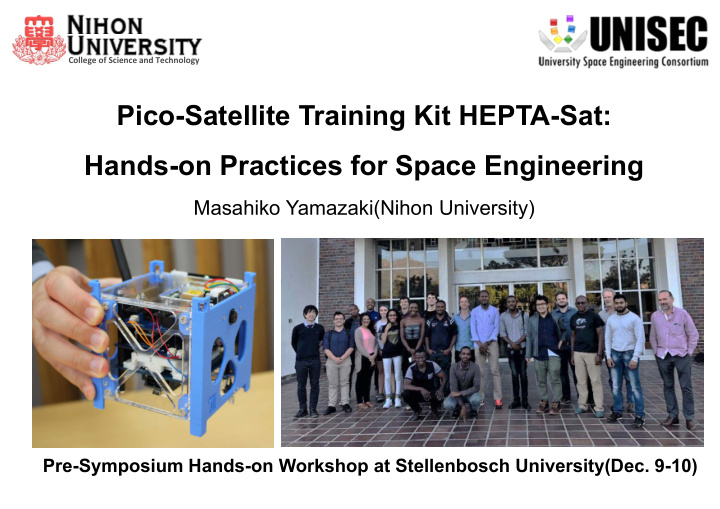



College of Science and Technology Pico-Satellite Training Kit HEPTA-Sat: Hands-on Practices for Space Engineering Masahiko Yamazaki(Nihon University) Pre-Symposium Hands-on Workshop at Stellenbosch University(Dec. 9-10)
College of Science and Technology Pre-Symposium Hands-on Workshop at Stellenbosch University(Dec. 9-10)
Operation Manual Sensor Board EPS & Comm. Board C&DH Board 3
9-axis GPS Flight Switch Antenna Thermal Sensor Memory Release Switch MPU 4
1U CubeSat Training Kit 5
Why CubeSat Training Kit? Satellite is possible to learn variety of elemental technologies Mechanical engineering, electronic engineering and communication engineering and it’s system integration. (Multi-disciplinary) To learn the space systems engineering, CubeSat development project based learning is a very effective training way. 3) Radiation 1) Vibration and Shock 2) Mechanical, Electronic, 5) Thermal Communication Eng. 6 4) High vacuum 6
Why CubeSat Training Kit? Satellite is possible to learn variety of elemental technologies Mechanical engineering, electronic engineering and communication engineering and it’s system integration. (Multi-disciplinary) To learn the space systems engineering, CubeSat development project based learning is a very effective training way. It is sometimes hard to gain knowledge or experience of the whole development process because the roles are divided into team members. 7
HEPTA-Sat Kit Composed of 6 function and 6 primary sub-systems. Function Subsystem You can learn how each subsystem functions and how to integrate subsystems into a satellite through experiencing the process of assembly , integration including programing & system implementation and test . 8
HEPTA-Sat Kit Pin socket Electrically connected through pin- sockets. Every board has same electrical interface. Spacer Physically connected and fixed with spacer. Electrical Interface 9
HEPTA-Sat Kit Effective and low-cost tool over a short amount of time by oneself or by team. Almost all major equipment is removable and can be integrated repeatedly. The textbook allows beginners to study the software, hardware, and ultra- small satellites efficiently and systematically on their own. Users can design, manufacture and integrate their own circuit board to run an original mission. (User board) 10
HEPTA-Sat Training Program Concept of Training: “Understanding basic satellite system architecture & Experiencing the pico-satellite development process” Goal of Training: “Experiencing the development process of ultra-small satellites in a short time and acquiring the basic knowledge of space engineering” 11
HEPTA-Sat Training Program EPS(Electrical Power Supply) Solar Switch Flight Pin Switch array Solar/DC ON/OFF (F-SW-1) Charger Flight Pin Release Detection Switch (F-SW-2) (R-SW) Charge Management voltage check GPS Satellites Controller 5.0V 3.3V Micro SD Battery converter converter (Memory) Battery cs Thermal Operational I/O sensor amplifier A/D converter SPI I/O Accelerometer GPS Gyroscope I2C Analog Magnetometer 2MB_Flash_Memory switch (UART) (OBC) Serial Camera Pwm Transceiver Mini- Vout USER Port I/O USB (3.3V) Wireless Programming UART 5V 500mA communication Ground station USB Transceiver PC 12
HEPTA-Sat Training Program 13
HEPTA-Sat Training Program 14
HEPTA-Sat Training Program 15
HEPTA-Sat Training Program 16
Recent Activities A hands-on class of about one day to a week was held for domestic and overseas Engineer, Researcher, University and High school students. 17
Recent Activities A hands-on class of about one day to a week was held for domestic and overseas Engineer, Researcher, University and High school students. It held in Japan in September, Nepal in October, Bulgaria in November and South Africa in December 2017. 18
Recent Activities A hands-on class of about one day to a week was held for domestic and overseas Engineer, Researcher, University and High school students. It held in Japan in September, Nepal in October, Bulgaria in November and South Africa in December 2017. 19
Conclusion Advanced satellite 1U CubeSat Benefits of a hands-on education based on small satellite are… Experience the whole system construction. Create ideas out of nothing and integrate and accomplish the system to work correctly. Learn time and cost management, how to deal with risks, and how to work in a team. Be given feedback from the real world, not a desk study but a real experience through developing an actual spacecraft. These learning experiences can create opportunities for in-depth study of the mission plan, specialized theory, design, development and experiment, also for students who wish to learn fields other than space. 20
Recommend
More recommend